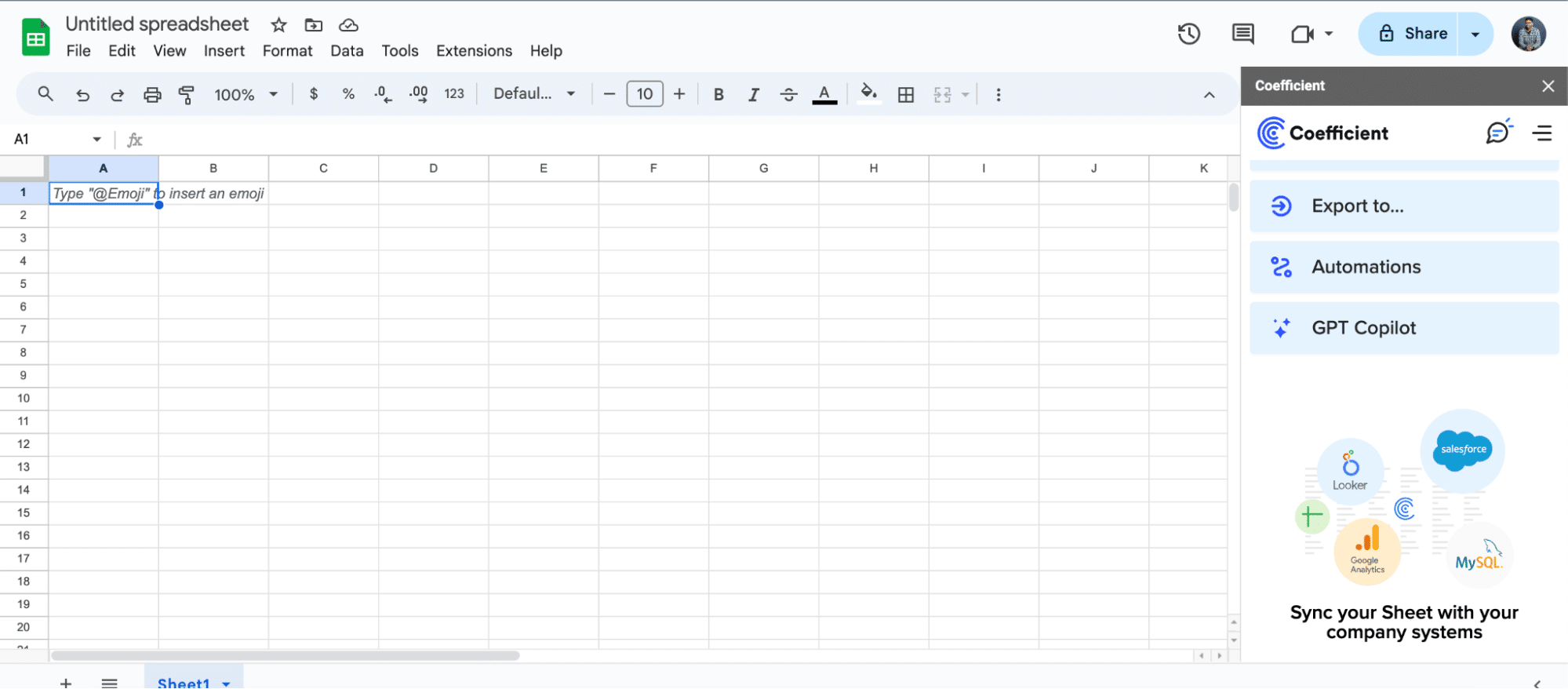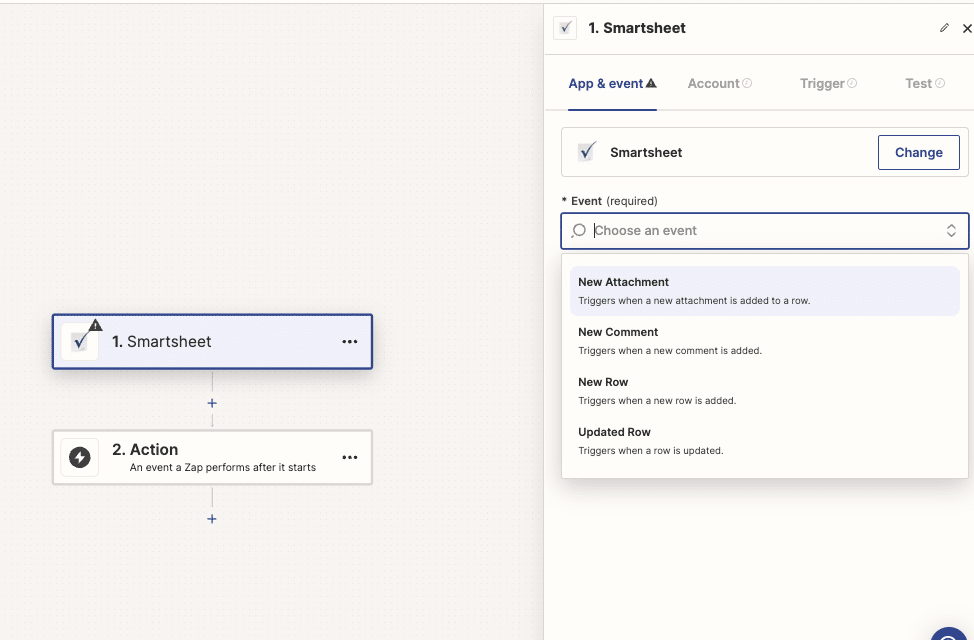While Smartsheet excels at streamlining workflows and boosting productivity, there are times when you may need to export your data to Google Sheets for further analysis, reporting, or sharing with stakeholders.
In this comprehensive guide, we’ll explore three methods for exporting Smartsheet data to Google Sheets: using Coefficient for automated exports, manual CSV exports, and setting up workflows with Zapier.
Method 1. Coefficient (No-Code, Automated)
Coefficient is spreadsheet connector that connects live business data to Google Sheets. It’s no-code interface makes it easy to export Smartsheet data to Google Sheets where you can combine it with data from your other company systems.
Pros and Cons
Pros:
- No-code setup process
- Real-time, automated data syncing
- Supports multiple data sources beyond just Smartsheet
Cons:
- Some advanced features, such as scheduled automations, are only available on paid plans. However, Coefficient’s pricing is still very competitive compared to other solutions.
Step-by-Step Tutorial
Step 1. Install Coefficient
- Open a new or existing Google Sheet, navigate to the Extensions tab, and select Add-ons > Get add-ons.
- In the Google Workspace Marketplace, search for “Coefficient.”
- Follow the prompts to grant necessary permissions.
- Launch Coefficient from Extensions > Coefficient > Launch.
Coefficient will open on the right-hand side of your spreadsheet.

With Coefficient installed, you’re now ready to import your Smartsheet data into your spreadsheet.
Click ‘Import from…’ from the Coefficient menu.

Navigate down the menu to find Smartsheet. Click ‘Connect.’

Click ‘Authorize’ to grant Coefficient access to Smartsheet.

Select ‘Allow’ and log in to your Smartsheet account when prompted.

Select ‘Start from Scratch’ after connecting Coefficient to Smartsheet.

Review the list of available objects you can import into Coefficient in the Preview menu.

Select ‘Import a Sheet.’
Note: You’ll need the Sheet ID of the sheet you wish to import to continue.
Navigate to the desired sheet in Smartsheet. Go to ‘File’ > ‘Properties.’

Copy the Sheet ID.

Paste the copied Sheet ID into the required field in Coefficient.

Click ‘Import’ to fetch the Smartsheet data into your spreadsheet.
Method 2: Manual CSV Export
Smartsheet allows you to export sheet data in CSV format, which can then be imported into Google Sheets. This method provides a quick way to get a snapshot of your Smartsheet data into a spreadsheet.
However, keep in mind that you’ll need to manually repeat the export process each time you want to update the data in Google Sheets.
Pros and Cons
Pros:
- User-friendly and accessible to all Smartsheet users.
- Quick and easy to perform.
- Suitable for most users’ needs.
Cons:
- Limited customization options.
- May not be suitable for advanced data manipulation or automation.
Step-by-Step Tutorial
- Log in to Smartsheet: Open Smartsheet and log in with your credentials.
- Go to the Sheet: Navigate to the sheet you want to export data from.
- Click on the File Menu: Find this at the top-left corner of the page.
- Select “Export”: Choose the export option and select “Export to CSV”.
- Choose Export Options: Select the appropriate options (e.g., All Rows, Specific Rows, All Columns, Specific Columns, etc.).
- Download the File: Once the export is complete, download the CSV file.
- Import into Google Sheets: Open Google Sheets and create a new spreadsheet. Go to File > Import, choose the downloaded CSV file, and follow the import wizard to import the data into Google Sheets.
Method 3: Zapier (Process-Level)
Zapier is a popular automation tool that allows you to connect Smartsheet with Google Sheets, enabling automated data export. With Zapier, you can set up a “Zap” that triggers whenever new data is added to Smartsheet and automatically sends that data to a Google Sheets spreadsheet. This method is ideal for keeping your Google Sheets data in sync with Smartsheet without manual intervention.

Stop exporting data manually. Sync data from your business systems into Google Sheets or Excel with Coefficient and set it on a refresh schedule.

Zapier is an automation platform that connects web apps, allowing you to create custom workflows called “Zaps” between tools like Smartsheet and Google Sheets.
Pros and Cons
Pros:
- Highly customizable workflows
- Supports a wide range of app integrations
- Ideal for complex, event-driven automations
Cons:
- Requires setting up a Zap, which may have a learning curve
- Limited by Zapier’s pricing tiers, which restrict the number of tasks and Zaps
Step-by-Step Tutorial
Step 1. Set up a Zapier Account: If you don’t have one already, sign up for a Zapier account at zapier.com.
Step 2. Create a New Zap: Click on “+ Create” in your Zapier dashboard.

Step 3. Choose Smartsheet as the Trigger App: Search for “Smartsheet” and select it as the trigger app. Choose the specific trigger event, such as “New Attachment.”

Step 4. Connect Your Smartsheet Account: Follow the prompts to connect your Smartsheet account to Zapier.
Step 5. Set up the Trigger: Customize the trigger settings, such as specifying the Smartsheet and Sheet you want to export data from.
Step 6. Choose Google Sheets as the Action App: Search for “Google Sheets” and select it as the action app. Choose the specific action event, such as “Create Spreadsheet Row”.

Step 7. Connect Your Google Sheets Account: Follow the prompts to connect your Google Sheets account to Zapier.
Step 8. Set up the Action: Map the Smartsheet data fields to the corresponding columns in your Google Sheets spreadsheet. Customize the spreadsheet settings as needed.
Step 9. Test and Activate the Zap: Test your Zap to ensure it’s working properly. If everything looks good, activate the Zap.
Seamlessly Export Smartsheet Data to Google Sheets
In this post, we’ve covered three powerful methods for exporting Smartsheet data to Google Sheets: using Smartsheet’s built-in export feature, manual CSV exports, and automated exports with Zapier.
Each approach has its own advantages and use cases, but if you’re looking for a quick, easy to use solution, Coefficient is worth considering. By leveraging Coefficient to connect Smartsheet and Google Sheets, you can supercharge your reporting, data analysis, and overall productivity.
Try Coefficient for free and start exporting your data to Google Sheets in minutes!


